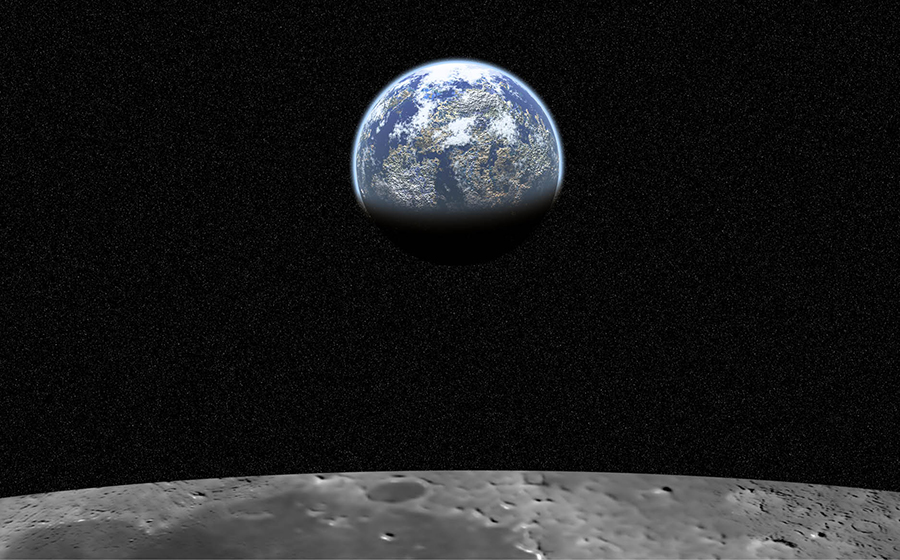Author\’s Note: When Robin asked me to write an article for The Robin Report, he said just do it about whatever\’s important to you right now. The following article is not one that describes inventory levels, gross margins, markdowns or macroeconomic trends. Though important, I thought I would put all those things aside and take the reader for a ride, literally, to space, and take a minute to share with you my perspective on where we are and where we are going. How we get there is another story that needs to be written by all of us.
Earthrise
On Christmas Eve 1968, Apollo 8 astronaut William Anders took a photograph of the earth as the spacecraft orbited the moon. \”Earthrise,\” as the picture is known, is one of the most famous and iconic photographs ever taken.
A transcript of the conversation between Anders, Jim Lovell and Frank Borman from the capsule captures that moment:
Anders: Oh my God! Look at that picture over there! There\’s the Earth coming up. Wow, that\’s pretty.?
Borman: Hey, don\’t take that, it\’s not scheduled. (joking)?
Anders: (laughs) You got a color film, Jim. Hand me that roll of color quick, would you…?
Lovell: Oh man, that\’s great!
On that same mission they photographed the first complete image of earth from space ever taken by humans. We didn\’t know it at the time, but together those two images transformed our perception of the world.
Only One Earth
Rachel Carson\’s book Silent Spring, published in 1962, was a watershed in bringing environmental concerns to the American public. The book was met with fierce opposition by corporate America, but it brought about numerous changes that gave rise to the environmental movement, as well as led to the creation of the Environmental Protection Agency in 1972. Both initiatives signaled a cultural and societal shift in the United States and around the world.
But if, as they say, a picture is worth a thousand words, then the images from Apollo 8 brought the premise of Silent Spring home in full and living color. The photographs gave us the perspective to realize our place in the universe and consolidated the environmental movement that Carson and others before her had planted the seeds of. The images are regarded as the most influential environmental photographs ever taken.
A Capsule with a View
The astronauts of the Apollo program went to space as hardened Air Force men and came back as philosophers. Every one of the Apollo astronauts I have talked to has said the same thing: That seeing the Earth from space changed their perspective on who and where we are in the universe, and they will never be the same because of it.
As Rusty Schweickart, an astronaut on Apollo 9 says, \”What we saw was a fantastic reality; the unbelievably beautiful home of all the life in our little corner of the Universe. What we realized was our responsibility for doing whatever we can do to extend and continue this amazing evolutionary experiment we call life.\”
Origins
\”…this amazing evolutionary experiment we call life\” is probably an understatement, and to understand it, we need to go back to the very beginning to realize how amazing it is.
In 1927, a Catholic priest and cosmologist George Lemaitre formulated the modern big-bang theory, which posits that the universe began in a cataclysmic explosion of a small, primeval \”super-atom.\” Lemaitre was the first to identify that the recession of nearby galaxies can be explained by a theory of an expanding universe and by formulating that, he developed the concept of the big bang.
That moment has been poetically named in scientific circles as \”The day without yesterday.\” In that millisecond of singularity over 13.8 billion years ago, the amount of energy released was unfathomable, and the matter that came from it is still all around us today and is eternally transformative, powerful and chaotic.
From this chaos the Earth was formed four billion years ago. Of the estimated 30 billion planets in our galaxy, Earth is the only planet we know that holds intelligent life as we understand it. So many things had to be just right for life to form on this planet; the distance from the sun, the rotation of its axis, the moon that defines our gravity. The earth exists in what scientists call the \”Goldilocks Zone,\” a place not too hot and not too cold, which allowed life to flourish in a form not found anywhere else in our galaxy. Knowing this, we realize the Earth is a diamond in a very, very, very large rough.
Bezos and Musk in Space
On September 12th, 1962, coincidentally 15 days before the release of Silent Spring, President John F Kennedy made his famous speech \”We chose to go the moon\” at Rice University in Houston, with the promise to land a man on the moon before the end of the 60s. The major goal of the Apollo project was to beat the Soviet Union in the space race, and to firmly establish Americas dominance of it.
Today\’s motivation is driven by other forces and it is fitting that simultaneous to the 50th Anniversary of Apollo 11 moon landing, space exploration is again having a major resurgence. NASA\’s recently announced its Artemis program to send humans back to the moon by 2024, plus private space companies like Blue Origin and SpaceX that are creating a radical shift in our thinking about the future development of space.
For centuries it has been in our nature to explore the stars, but rather driven by our curiosity, today it is also motivated by something larger. Jeff Bezos’ and Elon Musk’s individual visions of space exploration and settlement are very different, except for one similarity.
At his high school valedictorian in 1982, when he was 18 years old, Bezos unfurled his vision for space. A local newspaper reported at the time that his intention was \”to get all people off the Earth and see it turned into a huge National Park.\”
Obviously, Bezos\’ interest in space is not a recent awakening. Today, as he did then, Bezos imagines billions of people living in enormous space colonies, colonies that he has said would rival the climate and scenery of earth. His intention is to build the infrastructure for future generations to get to space by bringing down the cost of entry to future explorers and entrepreneurs.
He has said that Amazon wouldn\’t have been possible if the internet hadn\’t already been built. Now he sees a primary purpose of Blue Origin is to build that same infrastructure for space exploration. The mission statement of Blue Origin best sums it up: We\’re committed to building a road to space so our children can build the future.
Elon Musk has a slightly different vision of what our settlements in space will look like and focuses more on interplanetary colonies, notably Mars. But inhabiting the red planet is only one part of Musk\’s goal. In September 2019 while announcing his planned Mars mission spacecraft, Starship, that looks like something pulled straight from the pages of a pulp science fiction novel, he said, \”Consciousness is a very rare and precious thing, and we should take whatever steps we can to preserve the light of consciousness. I think we should do our very best to become a multi-planetary species and extend consciousness beyond Earth, and we should do it now.\”
How Space Matters
Obviously, the realization of these initiatives are decades if not centuries away. Both Bezos and Musk realize, as we all need to, that we live on a planet with finite resources and an unsustainable expanding population, and one way for our species to survive and grow is to look to space as a solution.
In the meantime, how do we as businesspeople, who measure our success in growth, contribute in our own way to balance the need for expansion with the sustainability issues that face us? Global manufacturing output has grown 78 percent in the last 15 years while the population has grown 18 percent. Of course we need take into account the growth of economies around the world which is bringing new consumers into the market. But even so, can we still achieve growth by producing less and producing smarter? This is a delicate balancing act we know, but there are solutions.
In many ways we need a new Apollo program, a game-changing radicalization of how and what we produce that is based more on need than desire. Not that we need to eliminate desire, in fact it is a necessary and important part of commerce, but how can we shift that desire to something more meaningful and conscious?
As I said, the earth is a diamond in a very large rough, and it is up to all of us to keep it polished. As my friend Bill Nye, Science Guy and CEO of the Planetary Society, says when asked what his favorite planet is, he always says, \”Earth, its where all my friends live.\”
To help give us some context and perspective, in 1994 Carl Sagan, who founded the Planetary Society, wrote and narrated a piece for a film called the Pale Blue Dot. The following is an excerpt, which perhaps best sums up our place in the universe.
\”From the distant vantage point of space, the Earth might not seem of any particular interest. But for us, it\’s different. Consider this dot. That\’s here, that\’s home, that\’s us. On it everyone you love, everyone you know, everyone you ever heard of, every human being who ever was, lived out their lives….every young couple in love, every mother and father, hopeful child, inventor and explorer…has lived here—on this spec of dust suspended in a sunbeam.”
Neil Armstrong\’s first words when he stepped onto the moon\’s surface 50 years ago still resonates with us: \”One small step for man, one giant leap for mankind.\” Today those words take on a new resilience and urgency. What small steps can we take today as business leaders, parents, partners or individuals that could help protect this diamond we live on that can contribute to a giant leap?
It is said if you want to go fast go alone, and if you want to go far, go together. We are all in this together and we have far to go. So let’s think of today as just the beginning: This is our day without yesterday. But at the same time, we should proactively address the challenges that lay ahead and recognize and appreciate that it is also the day before tomorrow.



